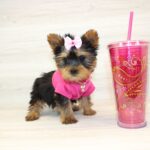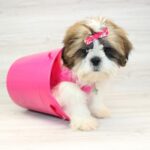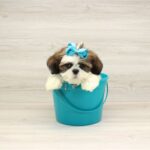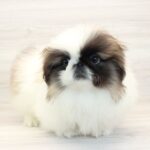If you’re thinking about adopting a Bolognese dog, you’ll need to know some basic information before you go shopping. This article will discuss some of the characteristics of this breed, including Height, Weight, and Grooming. This dog breed was originally developed in northern Italy, and is part of the toy dog group. Bolognese dogs are extremely sociable and are great companions. They also get along with other dogs and are excellent house pets.
Characteristics
The coat of the Bolognese is characteristically white with some ivory. This coat sheds a little but is not excessive. The Bolognese is also hypoallergenic. The Bolognese is an intelligent and adaptable dog. This breed can be trained very easily. It is quick to learn and can easily be housebroken. The Bolognese can easily be trained to use a potty pad and to ring a bell to alert owners when it is time to go potty.
As a companion dog, the Bolognese is extremely friendly, sociable, and loyal. They need daily attention and enjoy human companionship. While they may be aloof and reserved initially, they warm up to new people in a short time. The Bolognese is a watchdog, but they are not incessant barkers. Their intelligence and loyalty make them excellent companions for active families.
The Bolognese is not a high-energy breed, but the dog is easily trainable. Bologneses are relatively low-energy dogs and require at least one or two short daily walks to stay fit. They don’t require an excessive amount of exercise, but they do need plenty of mental stimulation to keep them happy and healthy. Because they are low-energy, they are a good choice for busy people who don’t have time to train a large breed.
The Bolognese is a playful, affectionate breed that thrives on human companionship. It is a great choice for families with older children. The Bolognese is not as fragile as other toy dogs and will be a great pet for kids. If rehomed before ten weeks of age, the Bolognese is the perfect companion for any family. The Bolognese also gets along well with other dogs.
The Bolognese is an intelligent and loyal breed that loves spending time with its owner. As a toy breed, the Bolognese should not be overly difficult to housetrain. The Bolognese is a hardy dog that can live up to 12-14 years. The Bolognese’s lifespan depends on size, build, activity level, and metabolism. It needs about one cup of food a day.
Height
The Bolognese dog breed is a bichon-type small dog that originated in Italy. Its name is a reference to Bologna in northern Italy, where it originated. This breed is classified as a companion dog because it craves attention and is a great house pet. It is good with other dogs. The average height of a Bolognese is approximately 12 inches tall, but he or she could be shorter or taller.
The Bolognese has a small head that is almost completely covered with hair. The head of the Bolognese is slightly longer than its muzzle. Its stop is distinct and is about one-third of the dog’s height. The muzzle is square, with a strong underjaw. The lips are black, but never bulge. The Bolognese dog is very sociable.
The Bolognese dog weighs about 8 to 14 pounds and is approximately nine to 12 inches tall. Its eyes are large and round, and its ears are high and folded downward. The Bolognese has a long tail and is very active. Its life span is about fourteen years, but some breeds can live up to 18 years. These small dogs are great companions for small families. If you plan to adopt a Bolognese, make sure you have plenty of time to train it.
The Bolognese is an excellent companion and makes a great therapy dog. His small size makes it easy to hug him, and it decreases tension. It brings a positive energy to all who come near him. So, don’t be shy about asking this breed about their size! It will be easy for you to find the right size for you! The height of the Bolognese dog is just right for you!
The Bolognese is one of the most interesting dogs in history. The breed is related to the Barbichon family, which originated from the small white dogs in Mediterranean countries. It is a cousin of the Maltese, Havanese, and bichon frise. Despite their short height, this breed has a reputation as a companion dog, and is recognized as a foundation stock service by the American Kennel Club.
Weight
The Bolognese dog breed originated in Italy and is a small, white, fluffy companion. This small dog breed is a favorite of ruling families and the nobility. Some of its famous owners include Madame Pomadour, Louis XIV of France, and Philip II of Spain. The Bolognese is often given as gifts amongst regions. Because of its small stature, it is small in weight, weighing six to fourteen pounds.
The Bolognese dog’s height and weight can vary from four to nine pounds, depending on the size of the dog. The female Bolognese weighs between 4.5 to nine pounds, which makes it suitable for smaller households. While the Bolognese is not particularly friendly, it is a good breed for those who enjoy socializing and playing. A Bolognese dog’s height is between ten and eleven inches, and its weight varies between four and nine pounds.
The Bolognese breed is prone to hip dysplasia. You should feed your Bolognese dog high-quality kibble with added chondroitin or glucosamine to combat this problem. Also, keep in mind that the Bolognese breed doesn’t require too much exercise – about 30 minutes of exercise per day should be sufficient. However, if your Bolognese dog is prone to developing health problems, you may want to consider feeding them a raw food diet.
The Bolognese breed was almost lost in World War 2 due to the decline of nobles in Italy. With the help of European breeders, the Bolognese was brought back to life and became a beloved pet for many Europeans. Presented in the ring of dog shows for the first time at Cruft’s in 2002, the Bolognese quickly became a popular dog around the world.
A Bolognese is a loyal, devoted companion dog who loves to be with his or her owner. Due to their high intelligence, Bolognese dogs are highly intelligent, but they can become bored and can be stubborn if not getting what they want. Bolognese dogs are generally low-energy and will curl up with their owners on the couch after training. They do well with children and other dogs and are also non-aggressive.
Grooming
When you first adopt a Bolognese puppy, you will need to take care of his grooming needs by regularly brushing his coat. You should start by bathing your puppy once every two weeks and increase the frequency when he grows to the adult coat. While Bologneses look fantastic with a long coat, many people prefer to keep the body in a puppy cut to simplify grooming. If you choose to cut your Bolognese’s coat, leave the ears alone to preserve the dog’s unique look. Likewise, you should check your dog’s coat after letting him out in the yard for burrs, dry grass, and thorns.
If you are a new dog owner, there are many essential things to keep in mind before grooming your Bolognese. This small, playful breed has an all-white coat and a silky, non-shedding texture. Despite the fluffy coat, the Bolognese needs regular brushing to keep it looking beautiful. This dog is also a good choice for families with children. Make sure to teach your children how to communicate with your dog so they will not be scared of the dog.
It is important to brush your Bolognese dog regularly to keep its coat looking its best. Brushing your dog’s coat will help spread the healthy skin oils through the hair shaft, making dirt slide off with ease. Regular brushing can also reduce the need for bathing. Lastly, regular brushing will strengthen the bond between you and your dog. But remember that grooming your Bolognese puppy is not as hard as you think it is!
Your Bolognese should visit the veterinarian as soon as possible after adoption. Your veterinarian will be able to detect any potential health issues and can prevent future ones. Also, if you have a Bolognese puppy with a tendency to develop tear stains, you should wash his face regularly with a damp cloth. You can also use a commercial tear stain remover for those stains.






